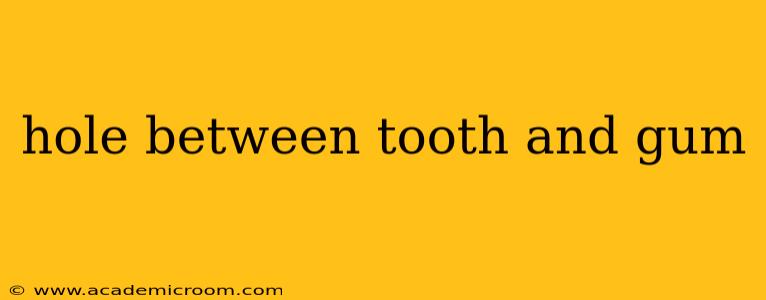A hole between your tooth and gum, often referred to as gum recession, is a common dental problem that can lead to sensitivity, discomfort, and even tooth loss if left untreated. This occurs when the gum tissue pulls back from the tooth, exposing the root. This article will explore the causes, symptoms, and treatment options for this concerning dental issue. We'll also address some frequently asked questions surrounding this problem.
What Causes a Hole Between Tooth and Gum?
Several factors can contribute to the development of a hole between your tooth and gum. These include:
- Aggressive brushing: Brushing too hard or using a hard-bristled toothbrush can damage gum tissue over time, leading to recession.
- Gum disease (periodontitis): This bacterial infection inflames and damages the supporting structures of the teeth, including the gums. Advanced gum disease is a major cause of gum recession.
- Genetics: Some individuals are genetically predisposed to gum recession, meaning they are more likely to experience it regardless of their oral hygiene habits.
- Teeth grinding (bruxism): This habit can put excessive pressure on the teeth and gums, contributing to recession.
- Misaligned teeth (malocclusion): Crooked or crowded teeth can make it harder to clean effectively, increasing the risk of gum disease and recession.
- Hormonal changes: Fluctuations in hormones, particularly during pregnancy or menopause, can make gums more susceptible to recession.
- Piercings: Oral piercings, particularly those near the gums, can cause irritation and contribute to recession.
- Certain medical conditions: Some medical conditions, such as diabetes, can increase the risk of gum disease and subsequent recession.
How Can I Tell if I Have Gum Recession?
The most noticeable symptom of gum recession is the appearance of a hole or gap between your tooth and gum. Other signs may include:
- Increased tooth sensitivity: Exposed tooth roots are more sensitive to hot, cold, sweet, or acidic foods and drinks.
- Loose teeth: As the supporting structures of the teeth are damaged, teeth may become loose.
- Bad breath (halitosis): Gum disease can cause bad breath.
- Red, swollen, or bleeding gums: These are signs of gum inflammation.
What are the Treatment Options for a Hole Between Tooth and Gum?
Treatment for gum recession depends on the severity of the problem and its underlying cause. Options include:
- Improved oral hygiene: Regular brushing and flossing with proper technique are crucial in preventing further recession.
- Scaling and root planing: This procedure removes plaque and tartar from below the gum line, helping to treat gum disease.
- Gum grafting: This surgical procedure involves taking tissue from another area of the mouth (often the palate) and grafting it onto the receding gum line.
- Guided tissue regeneration (GTR): This procedure uses a special membrane to encourage the regrowth of gum tissue and bone.
- Enamel matrix derivative (EMD): This gel-like substance can help to stimulate the regeneration of gum tissue.
Is Gum Recession Painful?
Gum recession itself isn't always painful, although it can lead to sensitivity and discomfort, particularly with hot, cold, or sweet foods. The pain associated with gum recession is often a symptom of the underlying gum disease.
Can Gum Recession Be Reversed?
While complete reversal of gum recession isn't always possible, the progression can be halted and in some cases, improved with appropriate treatment. The earlier the problem is addressed, the better the chances of successful treatment.
How Can I Prevent Gum Recession?
Preventing gum recession involves practicing good oral hygiene, visiting your dentist regularly for checkups and cleanings, and addressing any underlying medical conditions that might increase your risk.
What Happens if Gum Recession is Left Untreated?
Untreated gum recession can lead to increased tooth sensitivity, tooth loss, and potential infections. It's crucial to seek professional dental care to address the problem and prevent further complications.
This information is for general knowledge and does not constitute medical advice. It is essential to consult with a dentist or periodontist for diagnosis and treatment of gum recession. They can assess your individual situation and recommend the most appropriate course of action.
